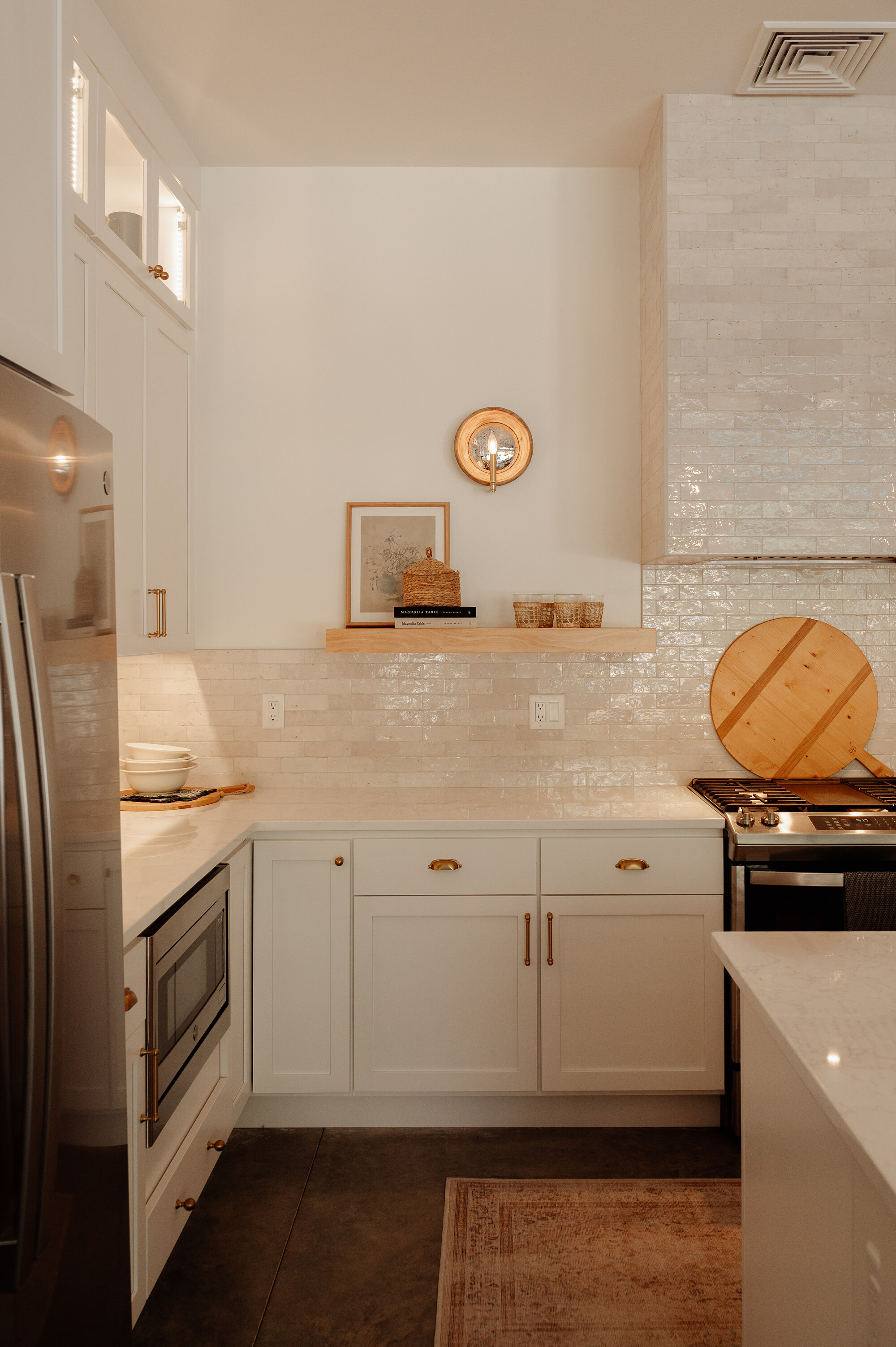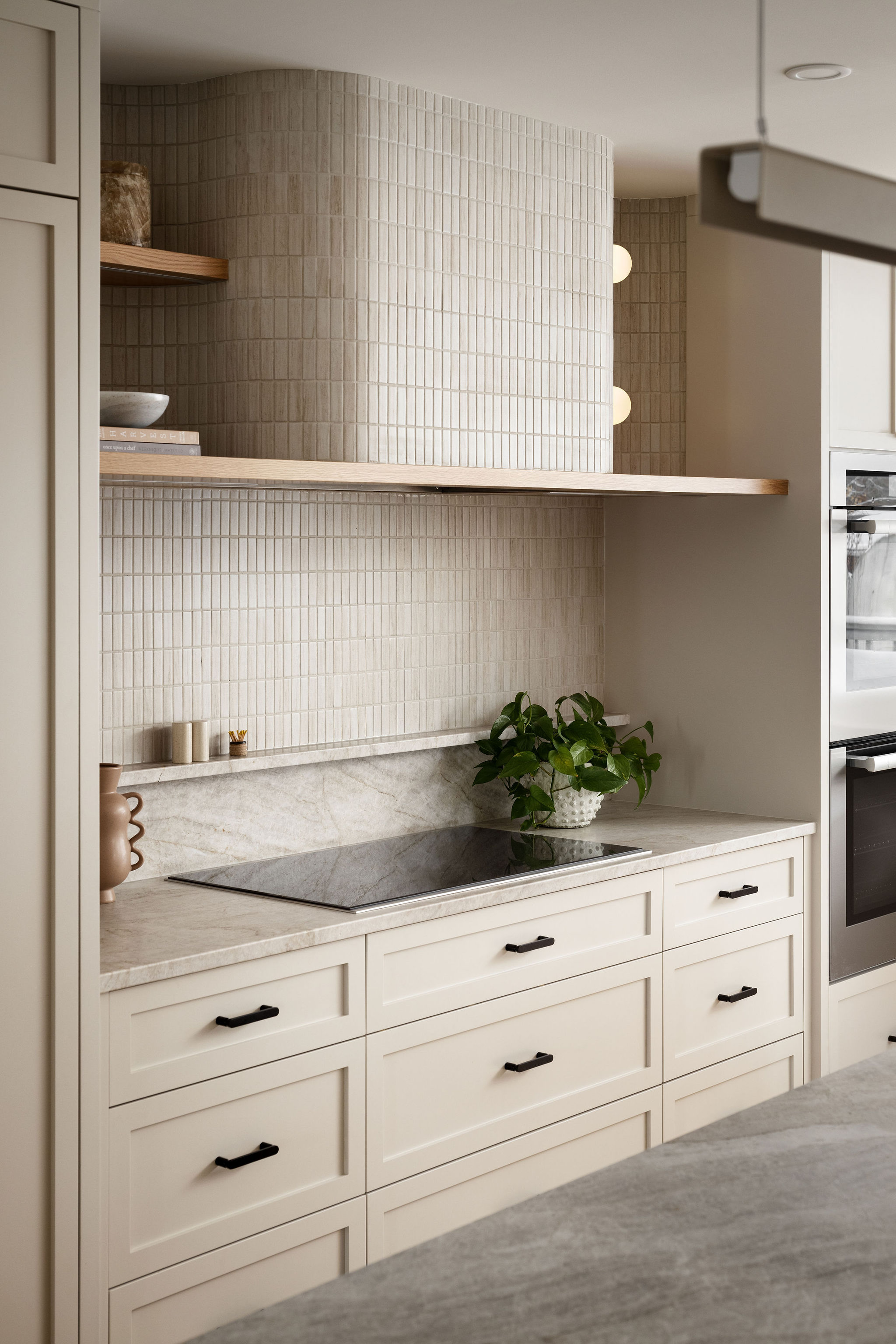Tiled Range Hoods Are the Trend That'll Make Your Kitchen Look More Expensive — I Love These 6 Examples
This idea takes a basic element of your kitchen design and makes it feel bespoke — and designers swear by it too


Good kitchen designs perfectly blends form and function, disguising and concealing those more unsightly yet essential household appliances and turning them into stylish design features. Your extractor is one such element of your kitchen that can often jar with a beautifully-designed space and disrupt the flow, but there's a way of concealing them with a simple, but stylish finish.
Tiled range hoods are gaining popularity for their ability to blend functionality with artistry. They offer an opportunity for creative expression in what is typically a utilitarian feature, introducing texture that enhances the kitchen's tactile quality. "Tiled range hoods are having a moment because kitchen hoods have become such a focal point of the kitchen," explains Brooke Mennen-Talsma of Brooke MT Interiors. "It’s a simple way to add so much more character than a drywall hood." It's a practical solution too, as tiles are durable and easy to maintain, essential for high-use areas like the kitchen.
Tiles can come in various forms and designs too, meaning there is plenty of ways to adopt the trend in your own kitchen to make something special of your extractor hood idea. From shimmering zellige tiles to smaller natural stone slabs, designers are using various material for tile range hoods today. Here are some of our favorite ways of doing it.
1. Blend the tiled hood with backsplash

This green kitchen by Vetter Architects cleverly blends the range hood with the backsplash for an back wall that has a strong sense of continuity.
The tiling style chosen for this kitchen is all about creating visual harmony, explains Jenni Vetter of Vetter Architects. "By extending the tiles across the entire wall, it introduces a warm, inviting texture that sets the mood of the space," she says.
Adding texture to the full wall elongates the room without overwhelming it too. "The tile forms a cohesive backdrop, allowing other design elements, such as the clerestory windows and custom metal shelving, to stand out while still maintaining a unified aesthetic," adds Jenni.
The olive green is another soothing element that keeps the space feeling warm and balanced. It complements the surrounding materials while offering a neutral yet rich backdrop.
"The variation in color within this handmade tile reflects light in a way that makes the kitchen feel both inviting and sophisticated. It also creates a subtle contrast with the bold, deep mahogany cabinets and black natural stone countertop, without competing for attention," she says. "Visually, it serves as a connector, tying together the color palette and materials to create a cohesive, polished look."
2. Use zellige tiles for a calming space

Kitchens with zellige tiles are having a moment. The way light bounces off the uneven surface of a zellige tile creates a shimmer in any space, and brings a room to life with light. "I love the imperfection of a zellige tile. The imperfections of the tile add character to the space and add an organic feel in a space that can otherwise feel a bit hard," says designer Tiffany Leigh.
In this kitchen by Brooke Mennen-Talsma of Brooke MT Interiors , using zellige tiling on a range hood helps foster that calming feel and the designer opted to connect the backsplash to the hood, creating a cohesive feel.
"Zellige style tiling gives a very lived-in, authentic feel to new-construction homes," says Brooke. "It creates a warmer aesthetic rather than everything appearing brand new and perfect and adds a lot of texture and dimension to a kitchen that would otherwise be too bright and white."
3. Use tiling to introduce texture

In all white kitchens, the risk is that a space will look flat and lack character. In this example by Tiffany Leigh Designs, the monotony of the white is broken up through clever use of texture, including the texture on the tiled hood. With a heavily veined marble island top and backsplash used against a simple white kitchen wall tile idea, the space feels more layered and tonal.
"We have a few different finish elements happening in this kitchen — putty perimeter cabinets, a wood-toned island, oil-rubbed bronze hardware and a stone countertop that wraps the wall," says Tiffany Leigh. "I like that the hood and the kitchen backsplash tile are cohesive — it keeps the kitchen from feeling too busy, but still interesting and unexpected in its treatment," she says.
4. Create a hood that stands out

The obvious temptation is to blend your range hood with the kitchen backsplash to create a seamless feel, but this design by Jaqui Seerman proves that standing out is sometimes the best solution.
"To honor the client’s desire to preserve the original wood paneling while incorporating new finishes and colors, we selected warm terracotta ceramic tiles from Waterworks, chosen for their similar width to the wood planks," explains Jaqui. "Installed vertically, these tiles complement the paneling while introducing a rich contrast in texture and color."
5. Try stacked tiles on a curved hood

Think about the shape of your tiles. These stacked tiles bring more texture and make a feature out of the grout lines. Designer Meghan Bannon of Mera Studio has used stacked tiles and a curved hood for something that plays with lines, shapes and shadow for a wonderful effect.
"Sometimes a monochromatic color scheme is all you need. When designing this home we knew we wanted to create a welcoming softness that pulled you into the newly opened space," says Meghan, founder at Mera Studio. "Tone on tone creams and subtle textures create a kitchen moment that is both easy and approachable."
6. Go for the glossy look

We’ve been seeing gloss and lacquer used in the kitchen too, with the trend for high gloss kitchen cabinets making a comeback. In this kitchen in Pacific Palisades, designed by Electric Bowery, deep Cordovan glossy tiles are used.
"The glossy range hood is really taking off," Electric Bowery's interior design director Stephanie Luk. What's more, going for a deep color like dark red, green, and even a deep, dark neutral gives a kitchen a little extra edge.
"The handcrafted feel, with slight variations in color and tone, adds character to a space. It creates a surface that feels very dynamic at every angle," adds Cayley Lumbar, principal of the studio. "The glossy finish reflects light at different times of the day, which not only brightens things up, in the day, but also add dimension at night. The texture of the tiles also adds depth, added visual interest, and makes a functional range hood feel considered in the overall design of any kitchen."
Opt for polished tiles to go for the glossy effect, or coat your tiles with a tile sealer to add lasting shine.
FAQs
Can you tile a range hood?
More and more designers are looking to range hoods as another place to have fun in the kitchen. "Designers are beginning to have a lot of fun with vent hoods — from plaster kitchen hoods to tile. I think people are looking at hoods to make a statement, and tile is easy to clean," says Tiffany.
Tiling a range hood is no easy feat and requires precision and expertise, especially if your hood is curved, but with the right preparation, it can be done smoothly and with fantastic results.
"Tiling a range hood sometimes requires cutting the tiles so they have a mitred edge, which usually requires a professional," says Tiffany. "Because of the weight, you need to make sure the wall is properly supported too."
"Doing things properly always demands a keen eye and attention to detail," warns Jaqui. "However, tiling stands out because it requires minimal machinery and, with care, can be installed by almost anyone. So, when comparing stainless steel, marble, and tile, tile is certainly the winner in terms of ease of installation."
The Livingetc newsletters are your inside source for what’s shaping interiors now - and what’s next. Discover trend forecasts, smart style ideas, and curated shopping inspiration that brings design to life. Subscribe today and stay ahead of the curve.

Former content editor at Livingetc.com, Oonagh is an expert at spotting the interior trends that are making waves in the design world. She has written a mix of everything from home tours to news, long-form features to design idea pieces, as well as having frequently been featured in the monthly print magazine. She is the go-to for design advice in the home. Previously, she worked on a London property title, producing long-read interiors features, style pages and conducting interviews with a range of famous faces from the UK interiors scene, from Kit Kemp to Robert Kime. In doing so, she has developed a keen interest in London's historical architecture and the city's distinct tastemakers paving the way in the world of interiors.

